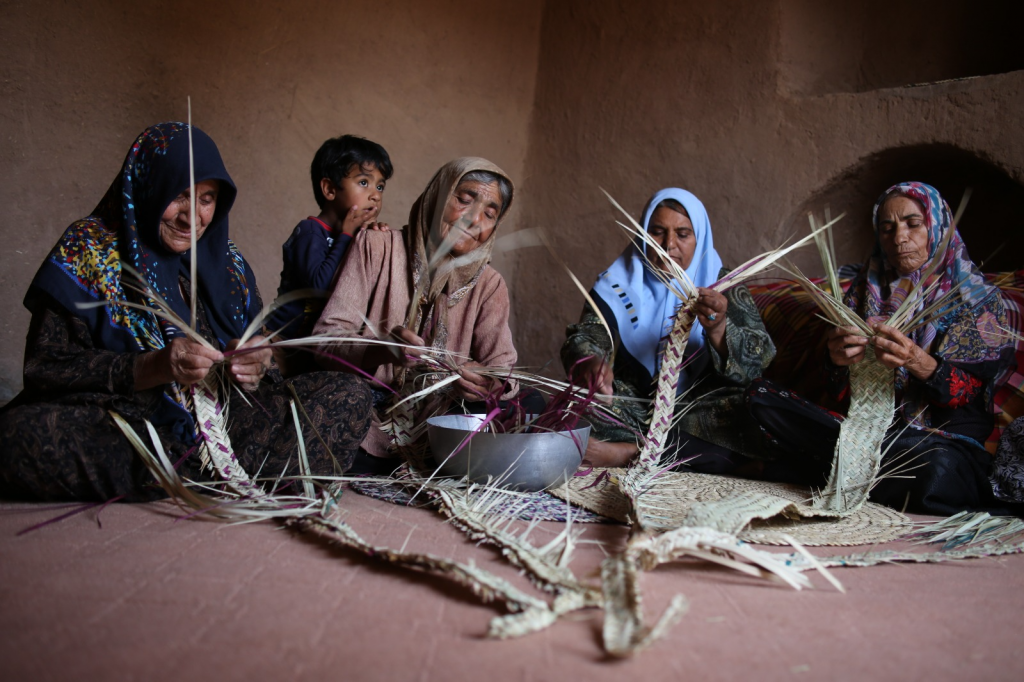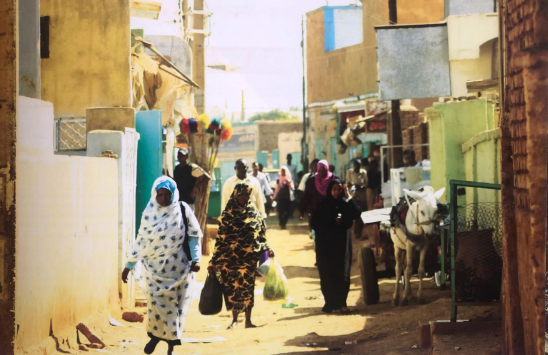Ubatuba, a nature reserve in Brazil; Rosetta, an Egyptian coastal city; Kerman, part of the Lut desert in Iran; Tuti island situated at the confluence of the White and Blue Nile in Sudan; and Kasese, on the outer edge of Uganda’s Rwenzori National Park: these five climate hotspots are the final innovation sites of ICCROM’s cascading capacity-development project, “Net Zero: Heritage for Climate Action.”
The Net Zero project aims to use Indigenous knowledge and traditional practices to mitigate food insecurity, environmental degradation, carbon emissions, forced migration and conflict over resources.
Using the scientific reports of IPCC and insights gathered from Climate.Culture.Peace, an international knowledge building project that reached 113 countries, ICCROM’s First Aid and Resilience for Cultural Heritage in Times of Crisis (FAR) programme has developed this first-of-its-kind initiative.
Indigenous knowledge and local knowledge, ecosystem-based adaptation and community-based adaptation are often found together in effective adaptation strategies and actions and together can generate transformative sustainable changes. Governance measures that transparently accommodate science and Indigenous knowledge can act as enablers of such co-production.
– IPCC, “Climate Change 2022: Impacts, Adaptation, and Vulnerability”
Organized with the support of the Swedish Postcode Foundation, the Net Zero project combines empirical research with training, field testing of mitigation and adaptation strategies, awareness raising, as well as policy-shaping activities. In the ongoing first phase, the field research will combine Geographical Information System (GIS) maps with the data gathered through interviews, recordings of oral histories and literature surveys.
With the help of a multidisciplinary team of 10 area specialists drawn from the fields of disaster risk reduction, climate and environmental science, urban planning, humanitarian and development aid, communications, peacebuilding and anthropology, ICCROM has developed a training model with core learning components. Pre-recorded lectures, individual team consultations and skill-building workshops are some of the diverse learning modes that are being used in the 20 month-long project.
Four emerging professionals were allocated to assist the innovation sites as ‘Sherpas’ to undertake robust and inclusive research, monitor progress, help communicate results, and liaise with the ICCROM-FAR team to promote the work being done at the innovation sites, The Sherpas will ensure an intergenerational knowledge exchange by engaging youth groups both locally, as well as internationally.
Participatory vulnerability and capacity assessments (VCAs) and co-creation are at the heart of the project. The overall aim is to identify approaches and conditions in which community-led heritage conservation can become a vector for climate action and sustainable development.
Meet the five Net Zero innovation sites
Site 1: Ubatuba, BRAZIL
 Ubatuba, Brazil. Source: UNICAMP
Ubatuba, Brazil. Source: UNICAMP
Ubatuba in Brazil is a natural reserve near São Paulo - one of the most populous cities of the Americas and a bustling business hub. Rich in water resources, Ubatuba is predominantly covered by the Atlantic rain forest and is bordered by 100 km of coast. This project will tap into the knowledge held by the marginalized local Quilombola communities on preserving crop diversity in the Ubatuba. Through verifiable research, the project team will develop inventory systems and seedling banks of native species to mitigate food insecurity. The team leading this project includes representatives of the Quilombola community and the Public Archaeology Laboratory (LAP) at the Centre for Environmental Studies and Research at the University State of Campinas (UNICAMP). They will be supported by local partners including ICOMOS-Brazil Climate Change and Heritage Committee, the Secretariat of Agriculture and Supply of the State of São Paulo (IAC), the Centro Nacional de Monitoramento e Alertas de Desastres Naturais - CEMADEN and the State University of Goiás’ history department.
 Rosetta, Egypt. Source: EHRF
Rosetta, Egypt. Source: EHRF
Site 2: Rosetta, EGYPT
Rosetta, or Rashid, is a port city on the Nile Delta and a World Heritage Site. Rosetta is known as the place where the Rosetta Stone was found. Today, the city is affected by a rising sea level and increased salinity of the river water. Net Zero will document and analyze the vernacular architectural practices and traditional ways of fishing to reduce the impacts of climate change on the lives and livelihoods of the local community. In close partnership with organizations of fishermen in Egyptian port cities - including Rosetta, Alexandria, Damietta and Port Said - the project will be implemented by the Egyptian Heritage Rescue Foundation (EHRF), together with Cairo University’s Community and Environmental section and the National Authority for Remote Sensing in Egypt.
Site 3: Lut Desert, IRAN
 The Lut Desert, Iran. Source: NDRI
The Lut Desert, Iran. Source: NDRI
The Lut Desert, or Dasht-e-Lut, is Iran's first natural site registered on the UNESCO World Heritage List. Also known as the hottest place on earth, the area suffers from prolonged periods of droughts. At this innovation site, the project will mitigate water scarcity by reviving the ancient water management system – qanat. Additionally, the project will empower a women-led team to carry out the plantation of Tamarix trees to enhance carbon sequestration, reduce desertification and strengthen peace and security. The project is conceived by the Natural Disasters Research Institute (NDRI) in close partnership with the Gojino community-based organization (CBO), which will be the key facilitator in the field.
Site 4: Tuti Island, SUDAN
 Tuti Island, Sudan. Source: SUDTT
Tuti Island, Sudan. Source: SUDTT
Tuti Island is situated at the confluence of the White and Blue Nile in Sudan and is surrounded by the metropolises - Khartoum, Omdurman and Khartoum North. In recent decades, the island has experienced increased temperatures, prolonged droughts and irregular rainfall patterns, as well as cyclic floods and sea level rise. In partnership with Studio Urban, University of Khartoum, Resurgence and UNDP, Sudan Urban Development Think Tank (SUDTT), the lead of this project, is working to enhance the existing community-led early warning system – Taya – in Tuti Island by cross-linking local knowledge with modern technology. Through the project, the team will create a localized and comprehensive forecasting system in and around the island to mitigate flood impacts.
Site 5: Kasese, UGANDA
 River Kabiri, Uganda. Source: CCFU
River Kabiri, Uganda. Source: CCFU
River Kabiri flows through Uganda’s Kasese district, between the Ekyisalhalha Kya Kororo sacred cultural site and the boundary of the Rwenzori Mountains National Park, a World Heritage Site. In the last decade, destructive flooding of River Kabiri, induced by irregular rainfall patterns and the rapidly melting glaciers of the Rwenzori Mountains, have disrupted the lives and livelihoods of lowland communities, such as the Bakonzo. The team leading this project comprises community leaders from the Bakonzo community and the Cross-Cultural Foundation of Uganda (CCFU), a local NGO. In close partnership with the Kasese District Local Government Authority, the cultural institution of the Bakonzo, known as Obusinga Bwa Rwenzururu, and the Uganda Wildlife Authority (UWA), the project team will tap into the Bakonzo community’s knowledge and experiences to plant and preserve native plant species to maximize carbon sequestration, control riverbank erosion and improve biodiversity in the region.
Net Zero: Heritage for Climate Action is comprised of four phases
- Phase 1: Situation analysis and data gathering
- Phase 2: In-person workshop
- Phase 3: Project implementation
- Phase 4: International symposium
In the ongoing Phase 1, teams at these five innovation sites will carry out research that will help develop place-specific climate stories. In Phase 2, these climate stories will help develop mitigation and adaptation strategies through an in-person workshop, which will be field tested in Phase 3 of the project. In the final Phase 4, the results of the entire Net Zero project will be disseminated at an online symposium that engages ICCROM’s partners from Net Zero and Climate.Culture.Peace.
Stay tuned for further discoveries from the innovation sites.
